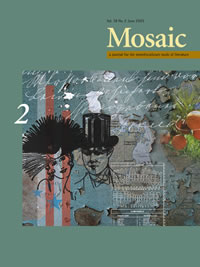Issue 38.2
Overview

General Issue
Published: June 2005
View the issue introduction or see the issue summary and contents below.
10 essays, totalling 192 pages
$16.95 CAD
How do particular narratives conflate violence and gift-giving? How does the gift betray a failure precisely through its affinity with violence? In this Mosaic issue, ten outstanding essays reflect on "the gift," primitivism, sadomasochism, nationalism, victimization, trauma, the oedipus complex and, not the least, love songs and prostitution.
What Maxie Knew: The Gift and Oedipus in What Maisie Knew and RushmoreDeanna K. Kreisel This essay examines the relationship between gift-giving and violence in texts about the Oedipus complex. It argues that in Henry James’s novel What Maisie Knew and Wes Anderson’s film Rushmore, a secondary repression is enabled by narrative techniques that mobilize a collective act of forgetting through the enjoyment of plot. | |
Jungle Creatures and Dancing Apes: Modern Primitivism and Nella Larsen’s QuicksandAmelia DeFalco This essay examines the repercussions of modernist primitivism on black subjectivity in Nella Larsen’s Quicksand. The essay forges intertextual connections between Larsen’s novel and contemporary cultural forms in order to untangle the cultural web of primitive fetishization that ensnares the protagonist. | |
Trauma and Sadomasochistic Narrative: Mary Gaitskill’s “The Dentist”Barbara Schapiro This essay applies trauma theory and relational psychoanalysis to a close reading of Mary Gaitskill’s short story “The Dentist.” It argues that the sadomasochistic relationship central to this story, and to much of Gaitskill’s fiction, is rooted in trauma and can be illuminated by an understanding of the post-traumatic condition. | |
Primacy, Technology, and Nationalism in Agnes Deans Cameron’s The New NorthWendy Roy This essay investigates primacy as evident in new technologies in Agnes Deans Cameron’s 1909 The New North. Cameron uses cameras, typewriter, and map to consolidate and expand upon the traveller’s conventional claim to be first, a claim that she enlarges to include gender, geography, ethnography, and nationalism. | |
Writing Back through the Body: Flesh and Spirit in the Work of Mary SwanderTodd F. Davis This essay explores the desire, or more accurately, the need to write back through the body that pulses beneath the lines of Mary Swander’s poetry and prose. | |
The Revolutionary Empowerment of Nature in Gioconda Belli’s The Inhabited WomanHélène de Fays By applying Mikhail Bahktin’s literary theory to The Inhabited Woman, this essay illustrates the way in which Belli’s work empowers nature as a speaking subject and, reflecting the beliefs of Native American cultures, restores the important relationship between human society and the natural world. | |
The Twilight Zone of Experience Uncannily Shared by Mark Strand and Edward HopperLaima Kardokas Although Strand has written books about artists, his poetry never is compared with visual art. This essay compares Strand with Hopper and offers an explanation of the Freudian as well as the ekphrastic nature of this correspondence through which aesthetic power is amplified, maximizing the possibility of expressing the Sublime. | |
Seeking Symbolic Immortality: Visualizing Trauma in Cat’s EyeLaurie Vickroy This study investigates how Cat’s Eye, a novel about an artist’s development, explores the complex interrelationship between trauma, identity, and culture, and specifically, how trauma shapes the construction of the protagonist’s gendered identity and visual sense while her artistic discipline mediates trauma and helps her decipher fantasies perpetuating her emotional stasis. | |
Still for Sale: Love Songs and Prostitutes from La Traviata to Moulin RougeGrace Kehler This essay challenges the prevailing notion of popular culture as debased by interrogating the fraught relationship with commodity culture Baz Luhrmann’s 2001 Moulin Rouge shares with its reviewers. | |
Patterns of Victimization in Light in AugustCaryl K. Sills A victim/victimizer pattern characterizes the troubled relationship between Joe Christmas and Joanna Burden, and it is this unreconciled paradox that leads to their tragic deaths. This essay analyzes victim/victimizer transformations through an interdisciplinary lens that draws together psychology, theology, education, the relatively new field of victimology, and Homi Bhabha’s negotiation theory. |